Hey there, let's dive into a topic that's close to our hearts: how we manage to balance the world of creating incredible scientific illustrations with our insatiable hunger for knowledge. You know, it's not easy being in our shoes. We're the ones who are passionate about both art and science, and that's what makes our journey so unique and exciting.
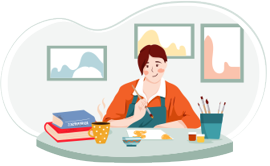
Think about it - we're not regular illustrators. We're the ones who bring scientific concepts to life through our art. Whether it's the intricacies of an atom's structure or the beauty of a faraway galaxy, we've got to capture the essence of it all.
And let's be real, it's not enough to just make things look pretty. We need to dive into the nitty-gritty details of what we're illustrating. That's what sets us apart.
But here's the thing - it's not all rainbows and unicorns. We've got this double role going on: the artist in us and the student of science. We're not just satisfied with making things look accurate; we're hungry to know the hows and whys behind it all. Biology, chemistry, physics - you name it, we're into it. It's like we've got this dual personality, and it's a challenge to keep both sides satisfied.
Our love for science is what drew us into this gig in the first place. We wanted to be the bridge between the complex world of science and the everyday folks who might not speak the scientific lingo. And we're darn good at it. But here's where it gets tricky - we need to keep up with all the new discoveries and advancements in our chosen fields. If science sneezes, we want to know about it. And trust me, science does a lot of sneezing these days.
So, how do we strike the right balance? How do we find time to brush up on our art skills while also staying updated with the latest scientific breakthroughs? Well, my friend, that's exactly what we're going to explore in this chapter. We're going to share our tips, tricks, and strategies for managing our time effectively, staying in the loop with the science world, and making the most of the digital tools at our disposal.
This chapter is like a survival guide for fellow scientific illustrators who are walking the same tightrope as us. We've been there, done that, and we're here to spill the beans on how to keep both the artist and the science nerd inside us happy.

So, buckle up and get ready for a journey into the heart of the balancing act that makes us the awesome scientific illustrators we are!
Finding Ways To Balance Your Creative Work With Ongoing Professional Development
Balancing the creative work of a scientific illustrator with ongoing professional development is a delicate equilibrium that holds the key to a thriving and sustainable journey. The symbiotic relationship between honing artistic skills and embracing continuous learning is a dynamic force that propels one's career forward.
By striking this equilibrium, you enrich your artistic palette with the vibrant hues of newfound knowledge, infusing depth and authenticity into your creations. The pursuit of balance ensures that your illustrations remain a canvas of innovation, fueled by the steady influx of insights from your ongoing learning endeavors.
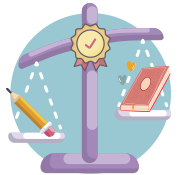
As you intertwine your creative expression with the pursuit of knowledge, you not only elevate your own craft but also contribute meaningfully to the intricate tapestry of scientific discovery and artistic excellence. Here are some techniques:
1. Time Blocking: Balancing Creativity and Learning
Allocate specific time blocks for both your creative work and ongoing professional development. Dedicate certain hours to illustration projects and separate slots for studying and skill enhancement. This way, you ensure that both aspects receive the attention they deserve without encroaching on each other's territory.
2. Theme Integration: Unifying Creativity and Study
Choose projects that align with your current areas of study. For instance, if you're learning about marine biology, consider creating illustrations related to marine life. This not only bridges your creative work and learning but also maximizes the value of both endeavors.
3. Learning Breaks: Nurturing Knowledge Between Tasks
Incorporate short learning breaks into your creative workday. During these breaks, read an article, watch a tutorial, or engage in a quick study session related to your field of interest. This habit ensures that professional development becomes an integral part of your daily routine.

4. Scheduled Study Sessions: Designated Learning Times
Set specific times for focused study sessions. Just as you allocate time for creative work, designate periods solely for learning and skill enhancement. This structured approach prevents your studies from getting lost in the shuffle.
5. Skill Upgrades: Continuous Learning as a Priority
Regularly assess your skill set and identify areas that need improvement. Dedicate specific periods to honing these skills, ensuring that your ongoing professional development aligns with your artistic growth.
6. Reflection Time: Consolidating Insights
After completing an illustration project, take some time to reflect on what you've learned during the process. Consider how your newfound knowledge can be applied to future projects, creating a bridge between your creative work and ongoing learning.
7. Networking and Collaboration: Learning Through Interaction
Engage with fellow scientific illustrators and professionals in your field. Collaborative projects, discussions, and networking events offer opportunities to learn from others while enriching your creative journey.
8. Continuous Evaluation: Adaptive Balance
Regularly assess how well you're balancing creative work and professional development. Adjust your approach based on your experiences – if you find that one aspect is dominating your time, recalibrate your schedule to ensure a more harmonious balance.
Conclusion
By integrating these techniques into your routine, you can seamlessly blend your creative work as a scientific illustrator with ongoing professional development. This balance not only nurtures your artistic growth but also empowers you to thrive in the dynamic landscape where creativity and knowledge intersect.

Navigating the Sea of Knowledge: The Vital Role of Selecting Reliable Information
In the ever-expanding realm of information, where data flows ceaselessly and knowledge seems abundant, the discerning eye of a scientific illustrator must be unfailingly vigilant. Let’s explore the critical importance of carefully choosing sources of information and knowledge, emphasizing that reliability is not just a luxury but an essential foundation for both learning and the creation of accurate, scientifically rigorous illustrations for your clients' projects.
The Landscape of Abundance
The digital age has ushered in an era of unprecedented access to information. While this abundance is a boon, it's accompanied by a challenge: the need to navigate through a sea of sources to uncover reliable, credible, and accurate information. For a scientific illustrator, this task is paramount, as the authenticity of your work hinges on the quality of your sources.

The Symbiosis of Learning and Illustration
Learning and illustrating are intertwined pursuits, forming the dual pillars of your profession. The knowledge you acquire shapes your ability to translate complex scientific concepts into visual narratives. Thus, the accuracy and reliability of your sources significantly impact the accuracy and credibility of your illustrations.
Creating a Foundation of Trust
Reliable sources provide a solid foundation of trust that underpins your work. When you draw from reputable and well-vetted information, you ensure that your illustrations are not only artistically captivating but also scientifically sound. This foundation of trust resonates with your clients and fellow professionals, fostering a reputation for meticulousness and precision.
Defining Reliable Sources
Reliable sources encompass peer-reviewed scientific journals, academic publications, trusted educational institutions, and recognized experts in the field. Peer review serves as a hallmark of reliability, indicating that the information has been scrutinized by experts for accuracy and validity.
Guarding Against Misinformation
In the digital age, misinformation and pseudo-science abound. The ability to discern reliable sources shields you from falling into the trap of inaccuracies and myths. By upholding a rigorous standard for your information intake, you safeguard the integrity of your work and the trust of your clients.
Strategies for Source Evaluation
1. Check Credentials: Investigate the author's credentials and expertise. A reputable expert adds credibility to the source.
2. Publication Source: Examine the source's origin. Peer-reviewed journals, academic institutions, and established research organizations are generally reliable.
3. Citation Trail: Follow the citations within a source to explore the foundation of the information presented. This offers insight into the depth of research.
4. Currency and Relevance: Ensure that the information is current and relevant to your subject. In rapidly evolving fields, outdated information can be misleading.
5. Bias and Objectivity: Analyze for any bias or vested interests that might influence the information presented. Seek sources that maintain objectivity.

The Legacy of Reliability
As a scientific illustrator, your work isn't confined to the present moment; it leaves a lasting legacy. The careful selection of reliable sources is your way of contributing to the accuracy and authenticity of scientific knowledge dissemination. Your illustrations become beacons of truth, crafted with the scientific rigor that advances the collective understanding of the world.
Time Saving
These trusted sources act as guiding lights, swiftly leading you to well-vetted information, saving you the valuable currency of time. With these sources as beacons, you will be able to navigate the labyrinth of information with precision, bypassing the maze of uncertainty and misinformation. The wealth of insights they offer allow you to dive deeper into your creative work and scientific exploration, confident that your research is grounded in accuracy and rigor. In essence, these sources not only serve as pillars of reliability but also as time-saving companions on your journey to excellence.
Conclusion
In conclusion, the act of choosing reliable sources of information and knowledge is an indispensable responsibility for a scientific illustrator. By meticulously curating your sources, you're not only nurturing your own growth but also fostering a culture of accuracy and reliability in the realm of scientific illustration. Remember that each brushstroke, each detail, and each stroke of accuracy is a testament to the respect you hold for the knowledge you convey through your art.
Your Personal Library: Why Having Books in Your Niche is a Game-Changer for Scientific Illustrators
Hey there, fellow illustrators! Let's talk about the magic of building your own book collection that's all about your specific area of scientific illustration. Yeah, we know, the internet is bursting with information, but there's something pretty special about having a collection of books that are like your secret allies in the world of knowledge. In this section, we'll dive into why having these specialized books is a total game-changer, helping you level up your illustration skills while keeping things scientifically legit.

Unlocking Wisdom Between the Pages
Picture this: each book in your collection is a window into a whole world of wisdom. These aren't just books; they're packed with insights, techniques, and discoveries that experts have carefully penned down. With each page you flip, you're diving headfirst into a treasure trove of knowledge waiting for you to uncover.
More Than Just Facts
Online sources can be a bit scattered, right? Specialized books, on the other hand, go deep – real deep. They don’t just skim the surface; they dive into every nook and cranny of your niche. From the tiniest details of an organism's anatomy to the broader picture of its environment, these books give you a 360-degree view that enriches your creative process in a big way.
A Safe Harbor in the Digital Storm
In a world where there's info overload online, books are like your rock. These aren't random blog posts; they're vetted by experts, gone through rigorous checks, and published by legit sources. They stand strong against the onslaught of questionable online info, giving you a solid foundation of credibility to build upon.
Your Cozy Nook of Learning
Imagine this: you’re chilling with a book that’s all about your niche. No pop-up ads, no notifications, just you and your thoughts. That’s what books offer – focused, uninterrupted learning. You get to explore each concept at your own pace, making notes, underlining passages, and truly engaging with the material.
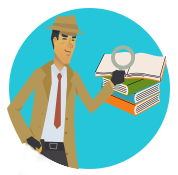
Getting Deeply Curious
These books invite you to explore thoughtfully. As you read, you're not just skimming the surface; you're delving into the content, pondering over illustrations, and soaking in every detail. This mindful approach pays off in your own illustrations, making them rich with insights and authenticity.
Building Your Own Legacy
Collecting these books isn't just about the now; it's an investment in your future legacy. Your collection grows with you, showing your journey from beginner to expert. They're not just books; they’re a visual story of your passion, curiosity, and growth.
A Spark for Your Creative Fire
The tactile experience of holding a book, flipping through its pages, and immersing yourself in its world – it’s a different kind of inspiration. These books spark your creativity in a way that screens can’t. They ignite your imagination, fueling your artistic adventures.
Tips for Your Book Adventure
1. What's Your Jam: Identify your niche in scientific illustration. Focus on books that match your area of interest.
2. Follow the Experts: Seek authors who are respected in your field. Their books are like golden nuggets of knowledge.
3. Mix It Up: Grab books from different authors. Diverse perspectives enrich your understanding.
4. Grow Gradually: Your collection doesn't need to explode overnight. Start with a few foundational books and build up over time.
5. Explore Locally: Hit up bookstores and libraries. You'll be surprised by the treasures you'll find.
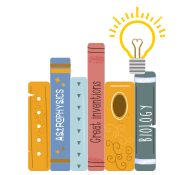
In a Nutshell
Having a collection of specialized books in your scientific illustration niche isn't just about filling up your shelves; it's about fueling your passion. It's like having a personal mentor in book form, guiding you through your artistic journey with wisdom and insights. So go ahead, flip through those pages, make notes in the margins, and let these books be your allies in the exciting adventure of scientific illustration.
Your Digital Toolbox: Online Courses,
Podcasts, and Videos
Let's talk about why it's a game-changer to put together a collection of online courses, books, podcasts, and videos tailored to your field of scientific illustration. In this section, we're diving into how these resources can be your secret sauce for growth, inspiration, and rocking it in the field of scientific illustration.
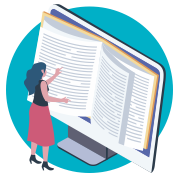
Learning from All Angles
Imagine having a whole bunch of learning options that fit your style. Got a thing for structured courses? Check. Love to dig deep into theories? Books got you. Need a dose of insights while jogging? Cue the podcasts. And when you want to see stuff in action? Videos are your jam. This variety gives you the power to learn in ways that really click with you.
Threads of Expertise
Think of each resource like a thread that weaves into your expertise tapestry. Online courses guide you step by step, making sure you nail those techniques. Books dive deep into the whys and hows, giving you the big picture. Podcasts let you hang out with pros, and videos turn complex stuff into a visual feast.

Learning on Your Terms
No more scheduling clashes or missing out. Online resources are open 24/7. Whether you're a night owl or a brunch learner, you get to choose when to dive in. It's like having your very own classroom that fits in your pocket.
Keeping Up with the Cool Kids
The world of scientific illustration is always evolving. Online courses, podcasts, and videos help you ride those waves of change. Staying in the loop doesn't just make you look smart; it keeps your skills fresh and your work super relevant.
Boosting Your Creative Mojo
Learning isn't just about facts; it's about getting that spark. Podcasts and videos are like backstage passes to industry experts' brains. Listening to their stories, ideas, and advice is like a shot of creative adrenaline.
Building Your Resource Arsenal
Online Courses: Pick ones that match your skill level and goals. Look for trusted platforms with experienced instructors.
Books: Build a mix of books, from basics to advanced techniques and those juicy theory reads.
Podcasts: Plug into podcasts that cover a wide range of topics. Perfect for your morning commute or chilling at home.
Videos: Follow YouTube channels or websites that break down techniques and tips visually.
Stay Curious: Keep exploring new stuff. Your resource collection is like a garden; it needs a bit of tending now and then.
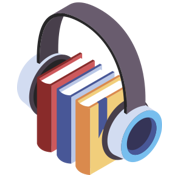
Brightening Your Learning Path
Gathering online courses, books, podcasts, and videos isn't just about collecting digital goodies; it's about leveling up your game. Think of them as your squad of mentors, guiding you toward mastery in scientific illustration. Each module, podcast, and video clip is like a little step toward being a rockstar in your field. So go on, dive into these resources, let them be your cheerleaders, and rock that scientific illustration world!
Welcoming the Learning Journey
Within Client Projects
In the delicate dance of balancing scientific illustration and continuous learning, a remarkable truth emerges: our client projects are not just assignments but gateways to profound understanding and learning.
This section delves into the art of trusting that while engrossed in client projects, we're also embarking on an immersive journey of scientific exploration. By embracing this symbiotic relationship, we enrich our expertise, infuse our illustrations with depth, and achieve a harmony that resonates with both artistic finesse and scientific rigor.

Beyond the Surface of Projects
Client projects, often seen as transactions, hold a hidden treasure trove of knowledge. Each project is an opportunity to delve into a new subject, from the intricate details of cellular structures to the grandeur of celestial phenomena. As scientific illustrators, we have the privilege to immerse ourselves in these subjects, transforming each project into a stepping stone toward mastery.
Bridging Artistry and Science
As we embark on client projects, we bridge the realms of artistry and science. Our illustrations become bridges, conveying complex scientific concepts in visual form. The process of translating abstract knowledge into tangible visuals requires deep understanding. Thus, our client projects aren't just about illustrations; they're about weaving science and art into a harmonious tapestry.
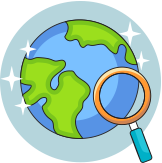
An Overture to Curiosity
A client's request isn't just a task; it's an invitation to curiosity. Whether it's capturing the intricacies of a species' morphology or illustrating the mechanisms of a scientific process, these tasks lead us down a path of exploration. We ask questions, dissect concepts, and analyze contexts, all of which ignite the spark of learning within us.
Harvesting a Wealth of Insights
With every project, we dissect scientific literature, engage with subject matter experts, and immerse ourselves in the minutiae of a subject. These encounters expand our horizons, infusing our repertoire with a diverse array of scientific concepts that enrich our future work.
The Dance of Trust
Trusting in the learning potential of client projects is a dance of its own. It's about acknowledging that every stroke of the brush and every pixel in our digital creations is a step towards deeper understanding. It's about embracing the idea that learning isn't confined to formal study sessions; it's intricately woven into the fabric of our professional lives.
Practical Strategies for Synthesis
1. Curate Your Mindset: Approach each project with a mindset of curiosity and exploration. See it as an opportunity to learn alongside creating.
2. Dive into the Subject: Immerse yourself in the scientific context of the project. Read relevant literature, engage with experts, and question assumptions.
3. Document Your Insights: Maintain a journal where you jot down the scientific knowledge you acquire through projects. Reflect on how it enhances your understanding.
4. Integrate Learning Breaks: During the project, take intentional breaks to delve into related scientific material. This helps reinforce your understanding and inspiration.
5. Engage with Clients: Collaborate closely with clients, discussing the scientific nuances. This not only ensures accuracy but also deepens your understanding.
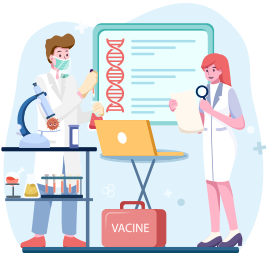
A Symphony of Growth
Our journey as scientific illustrators is a harmonious symphony, with each client project contributing a unique melody of learning. By embracing the inherent educational potential of these projects, we nurture an art form that goes beyond aesthetics, transcending into a realm where each illustration is a testament to our mastery of both art and science. In this dance of creativity and learning, we find not only balance but also an enriching tapestry of expertise that defines our craft.
